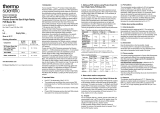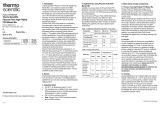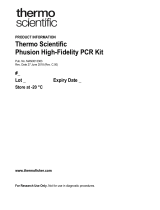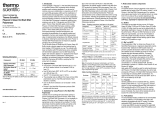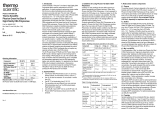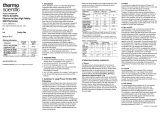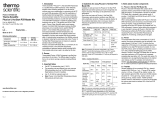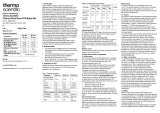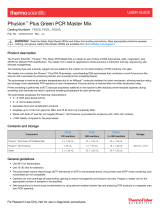Page is loading ...

USER GUIDE Pub. No. MAN0017414 Rev. A.0
Thermo Scientific™ Lyo-ready Phusion™ Hot Start II High-Fidelity DNA Polymerase
Enzyme characteristics
Hot-start: Afbody™ technology
Length: Up to 20kb
Fidelity vs. Taq:>50X
Format: Separate components
PCR setup
Component 50-µL rxn Custom Final conc.
Water, nuclease-free to 50µL to µL —
5X Phusion™ Buffer110µL µL 1X
10mM dNTP mix 1 µL µL 0.2mM each
10µM forward primer22.5µL µL 0.5µM
10µM reverse primer2 2.5µL µL 0.5µM
Template DNA3varies varies varies
DMSO (optional)41.5µL µL 3%
Lyo-ready Phusion™ Hot StartII DNA
Polymerase (2U/µL) 0.5µL µL 0.02U/μL
1 5X Phusion™ HF Buffer is the default reaction buffer for high-delity amplication.
5XPhusion™ GC Buffer can be used for GC-rich templates or those with complex secondary
structures (see “Optimization strategies” for more information). 5XPhusion™ HF Buffer and
5X Phusion™ GC Buffer both contain 7.5 mM MgCl2
2 The recommendation for nal primer concentration is 0.5μM, but it can be varied in the
range of 0.2–1.0μM if needed.
3 50–250ng gDNA or 1pg–10ng plasmid DNA per 50-μL reaction (see “Optimization
strategies” for more information).
4 Addition of DMSO is recommended for GC-rich (>65%) amplicons. DMSO is not
recommended for amplicons with very low GC content or amplicons that are >20kb.
PCR protocol
See page 2 and page 3 to prepare and run your PCR experiment.
Optimization strategies
Click here for guidelines to optimize your PCR experiment.
Purchaser notification
Click here for Limited Warranty, Disclaimer, and Licensing information.
Contents Sample Kit No.
EP1990SMP1
Size
500Units Kit contents
Storage
conditions ∤Store all contents at –20°C. Product is designed to withstand at
least 10 freeze-thaw cycles.
Required
materials
∤Template: gDNA, plasmid DNA, phage DNA, cDNA
∤Forward and reverse gene-specic primers
∤Invitrogen™ E-Gel™ General Purpose Gel, 1.2%
(Cat.No.G501801)
∤Invitrogen™ TrackIt™ 1kb Plus DNA Ladder (Cat.No.10488085)
∤0.2 or 0.5-mL nuclease-free microcentrifuge tubes
∤Gel loading buffer
∤Water, nuclease-free
Timing Varies depending on amplicon length.
Product
description
∤Thermo Scientic™ Lyo-ready Phusion™ Hot Start II DNA
Polymerase combines unique proofreading enzyme properties
and compatibility with lyophilization. Lyo-ready enzyme
formulation contains minimal amount of glycerol (≤0.5%) and
retains all favorable standard Phusion™ DNA Polymerase (with
50% glycerol) properties– high delity, increased processivity,
and resistance to common reaction inhibitors. The combination
of these features offers high exibility in terms of lyophilized
enzyme format that meets high performance requirements for
detection assays.
∤The enzyme combines DNA polymerase and a reversibly
bound, specic Afbody™ protein, which inhibits the DNA
polymerase activity at ambient temperatures, thus preventing
the amplication of non-specic products.
∤The Afbody™ ligand also inhibits the 3’to5’ exonuclease
activity of the polymerase, preventing degradation of primers
and template DNA during reaction setup. At polymerization
temperatures, the Afbody™ molecule is released, rendering
the polymerase fully active.
∤Phusion™ Hot StartII DNA Polymerase has 5'to3' polymerase
and 3'to5' exonuclease activities. It produces blunt-end DNA
products.
Important
guidelines Click here for important PCR guidelines.
Online
resources For further information, contact LCSVilnius@thermosher.com.
For Research Use Only. Not for use in diagnostic procedures.
Print Options

-2-
PCR procedure
The example PCR procedure below shows appropriate volumes for a single 50-µL reaction. For multiple reactions, prepare a master mix of components common to all reactions
to minimize pipetting error, then dispense appropriate volumes into each 0.2-mL or 0.5-mL PCR tube before adding template DNA and primers. When using the lyo-ready
Phusion™ Hot Start II DNA Polymerase, the PCR setup can be performed at room temperature.
Step Action Procedure details
1 Thaw reagents Thaw, mix, and briey centrifuge each component before use.
2 Prepare PCR mix
a. Add the following components to each PCR tube.
Note: Consider the volumes for all components listed in the table to determine the correct amount of water
required to reach your nal reaction volume.
Component 50-µL rxn Final conc.
Water, nuclease-free to 50µL —
5X Phusion™ HF Buffer110µL 1X
10mM dNTP mix 1µL 0.2mM each
10µM forward primer2 2.5µL 0.5μM
10µM reverse primer22.5µL 0.5μM
Template DNA3varies varies
DMSO (optional)41.5µL 3%
Lyo-ready Phusion™ Hot StartII DNA Polymerase 0.5µL 0.02U/μL
1 5X Phusion™ HF Buffer is the default reaction buffer for high-delity amplication. 5 X Phusion™ GC Buffer can be used
for GC-rich templates or those with complex secondary structures (see “Optimization strategies”, page 1). 5XPhusion
HF Buffer and 5X Phusion GC Buffer both contain 7.5 mM MgCl2.
2 The recommendation for nal primer concentration is 0.5μM, but it can be varied in the range of 0.2–1.0μM if needed.
3 50–250ng gDNA or 1pg–10ng plasmid DNA per 50-μL reaction (see “Optimization strategies”, page 1).
4 Addition of DMSO is recommended for GC-rich amplicons. DMSO is not recommended for amplicons with very low GC
content or amplicons that are >20kb.
b. Cap each tube, mix, then briey centrifuge the contents.

20 September 2018
For support, visit thermofisher.com/support.
-3-
Step Action Procedure details
3
Incubate reactions in a
thermal cycler
Step
2-step protocol 3-step protocol
Temp. Time Temp.Time
Initial denaturation 98°C 30sec 98°C 30sec
25–35
PCR
cycles
Denature 98°C 5–10sec 98°C 5–10sec
Anneal1— — varies 10sec
Extend 72°C 15–30 sec/kb 72°C 15–30sec/kb
Final extension 72°C 5–10min 72°C 5–10min
4°C hold 4°C hold
1 IMPORTANT! The optimal annealing temperature for Phusion™ Hot Start II DNA Polymerase may differ signicantly from
that of Taq-based polymerases. Always use the Tm calculator at thermosher.com/tmcalculator to calculate the Tm of your
primers and the recommended annealing temperature. The 2-step protocol is recommended when primer Tm values are at
least 69°C (>20nt) or 72°C (≤20nt), when calculated with our Tm calculator.
Note: Refer to “Optimization strategies”, page 1, for guidelines to optimize cycling conditions.
4
Add gel loading buffer and
analyze with gel
electrophoresis
a. Add gel loading buffer to 10µL of PCR product, mix, then briey centrifuge the contents.
b. Analyze the sample using agarose gel electrophoresis.
c. Use your PCR product immediately in down-stream applications, or store it at –20°C.
/
